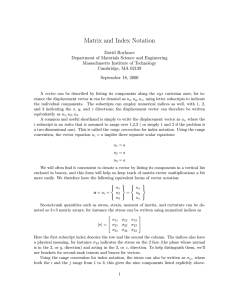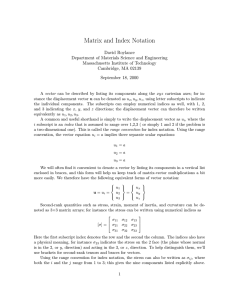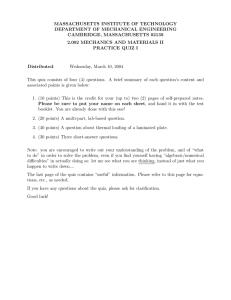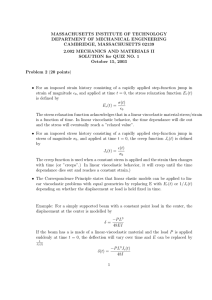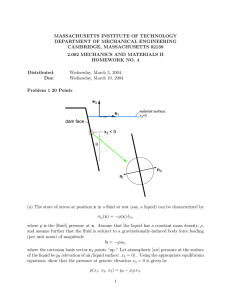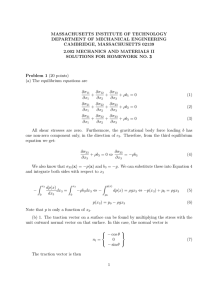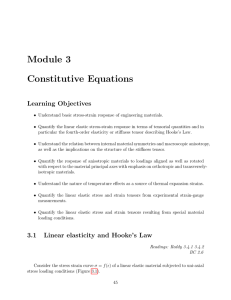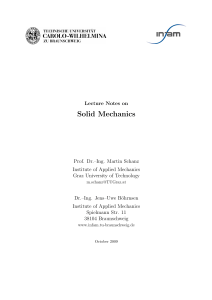Document 13562488
advertisement
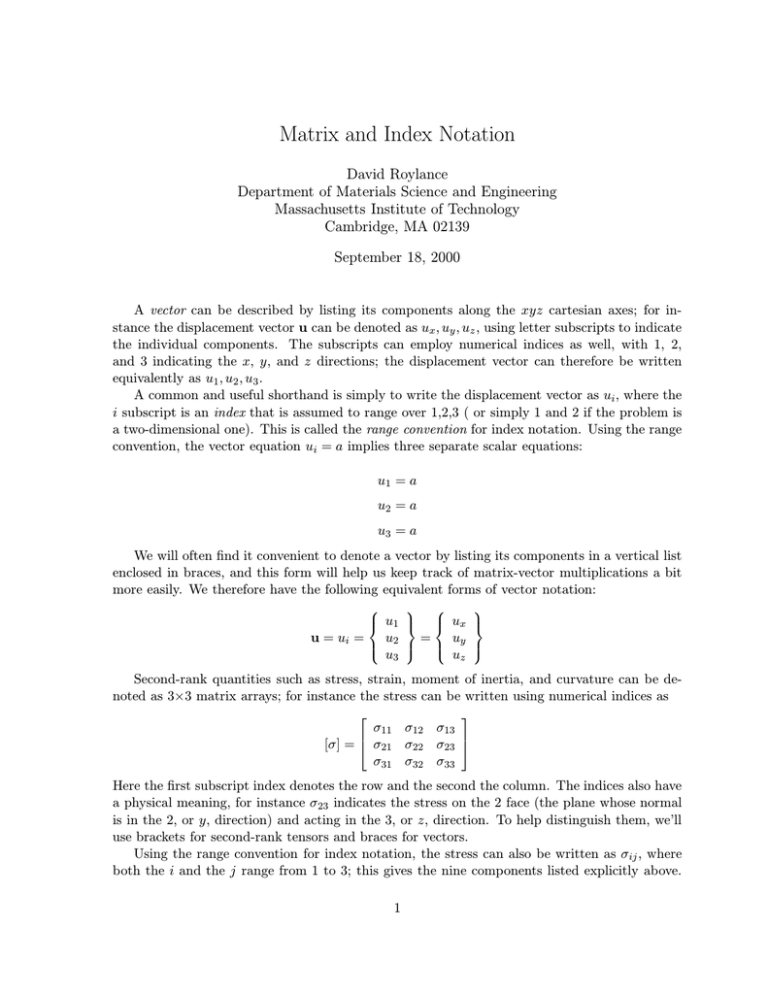
Matrix and Index Notation David Roylance Department of Materials Science and Engineering Massachusetts Institute of Technology Cambridge, MA 02139 September 18, 2000 A vector can be described by listing its components along the xyz cartesian axes; for in­ stance the displacement vector u can be denoted as ux , uy , uz , using letter subscripts to indicate the individual components. The subscripts can employ numerical indices as well, with 1, 2, and 3 indicating the x, y, and z directions; the displacement vector can therefore be written equivalently as u1 , u2 , u3 . A common and useful shorthand is simply to write the displacement vector as ui , where the i subscript is an index that is assumed to range over 1,2,3 ( or simply 1 and 2 if the problem is a two-dimensional one). This is called the range convention for index notation. Using the range convention, the vector equation ui = a implies three separate scalar equations: u1 = a u2 = a u3 = a We will often find it convenient to denote a vector by listing its components in a vertical list enclosed in braces, and this form will help us keep track of matrix-vector multiplications a bit more easily. We therefore have the following equivalent forms of vector notation: u = ui = ⎧ ⎫ ⎪ u1 ⎪ ⎨ ⎬ u 2 ⎪ ⎩ u ⎪ ⎭ 3 ⎧ ⎫ ⎪ ⎨ ux ⎪ ⎬ = u y ⎪ ⎪ ⎩ u ⎭ z Second-rank quantities such as stress, strain, moment of inertia, and curvature can be de­ noted as 3×3 matrix arrays; for instance the stress can be written using numerical indices as ⎡ ⎤ σ11 σ12 σ13 ⎢ ⎥ [σ] = ⎣ σ21 σ22 σ23 ⎦ σ31 σ32 σ33 Here the first subscript index denotes the row and the second the column. The indices also have a physical meaning, for instance σ23 indicates the stress on the 2 face (the plane whose normal is in the 2, or y, direction) and acting in the 3, or z, direction. To help distinguish them, we’ll use brackets for second-rank tensors and braces for vectors. Using the range convention for index notation, the stress can also be written as σij , where both the i and the j range from 1 to 3; this gives the nine components listed explicitly above. 1 (Since the stress matrix is symmetric, i.e. σij = σji , only six of these nine components are independent.) A subscript that is repeated in a given term is understood to imply summation over the range of the repeated subscript; this is the summation convention for index notation. For instance, to indicate the sum of the diagonal elements of the stress matrix we can write: σkk = 3 � σkk = σ11 + σ22 + σ33 k=1 The multiplication rule for matrices can be stated formally by taking A = (aij ) to be an (M × N ) matrix and B = (bij ) to be an (R × P ) matrix. The matrix product AB is defined only when R = N , and is the (M × P ) matrix C = (cij ) given by cij = N � aik bkj = ai1 b1j + ai2 b2j + · · · + aiN bN k k=1 Using the summation convention, this can be written simply cij = aik bkj where the summation is understood to be over the repeated index k. In the case of a 3 × 3 matrix multiplying a 3 × 1 column vector we have ⎡ ⎤⎧ ⎪ b1 a11 a12 a13 ⎨ ⎢ ⎥ b ⎣ a21 a22 a23 ⎦ ⎪ 2 a31 a32 a33 ⎩ b3 ⎫ ⎪ ⎬ ⎪ ⎭ ⎧ ⎫ ⎪ ⎨ a11 b1 + a12 b2 + a13 b3 ⎪ ⎬ = a b +a b +a b 21 1 22 2 23 3 ⎪ ⎪ ⎩ a b + a b + a b ⎭ 31 1 32 2 = aij bj 33 3 The comma convention uses a subscript comma to imply differentiation with respect to the variable following, so f,2 = ∂f /∂y and ui,j = ∂ui /∂xj . For instance, the expression σij,j = 0 uses all of the three previously defined index conventions: range on i, sum on j, and differentiate: ∂σxx ∂σxy ∂σxz + + =0 ∂x ∂y ∂z ∂σyx ∂σyy ∂σyz + + =0 ∂x ∂y ∂z ∂σzx ∂σzy ∂σzz + + =0 ∂x ∂y ∂z The Kroenecker delta is a useful entity is defined as � δij = 0, 1, i �= j i=j This is the index form of the unit matrix I: ⎡ ⎤ 1 0 0 ⎢ ⎥ δij = I = ⎣ 0 1 0 ⎦ 0 0 1 So, for instance 2 ⎡ ⎤ σkk 0 0 ⎢ ⎥ σkk δij = ⎣ 0 σkk 0 ⎦ 0 0 σkk where σkk = σ11 + σ22 + σ33 . 3
